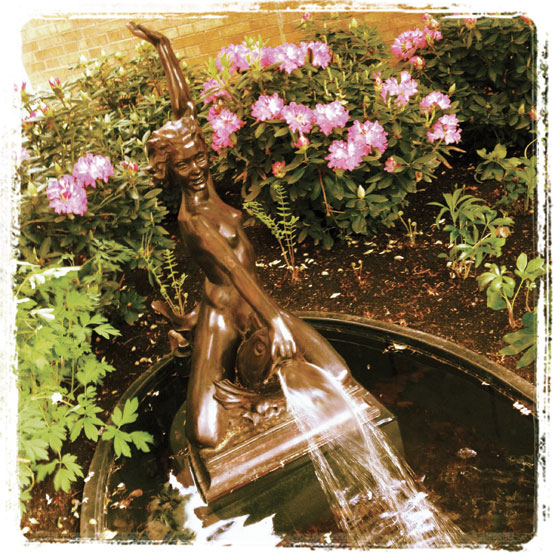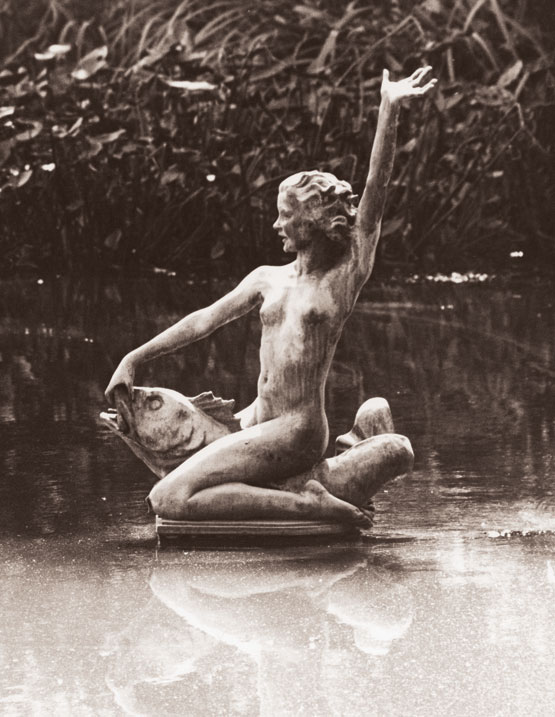Mystery Maiden
When a long-lost sculpture unexpectedly returns to Vassar, the surprise raises as many questions as answers.

Late last summer, a white panel truck pulled up to the loading docks at Vassar’s shipping and receiving bay with a delivery. A note accompanying the unexpected shipment said it was for the occasion of the college’s Sesquicentennial. Inside the truck was a lone sculpture. As administrators would soon discover, it wasn’t a gift, but rather a return.
The sculpture was “Call of the Sea” by Harriet Whitney Frishmuth, a sculptor noted for her stunning female bronzes, many produced just prior to the Great Depression. Commissioned in 1923, the bronze, measuring only four feet tall, had as its model the diminutive ballerina Madeleine Parker.
Between 1924 and 1939, fewer than 20 copies were made from the original mold by a Rhode Island foundry. Only a handful remain known today, in places such as New York (the Brooklyn Botanic Gardens), South Carolina, Indiana, Ohio, and Oklahoma.
And then there is Vassar’s copy, which Mrs. Charles Higley gave to the college in 1954, when it was placed on Sunset Lake. There it remained, more or less, for 20 years. Vassar Historian Elizabeth Daniels ’41, who has served as a professor of English, dean of freshman, and dean of studies during her more than 60 years at the college, recalls several instances of the sculpture temporarily disappearing, thanks to the prank-pulling men of Yale. But the sculpture always returned. Later, it was presumed to have been pushed to the bottom of the shallow lake. Then—most likely in the late 1970s, when Sunset Lake was drained and dredged—the sculpture disappeared without a trace.
When “Call of the Sea”—long considered lost to the college—inexplicably returned “it was a true surprise,” says James Mundy ’74, the Anne Hendricks Bass Director of Vassar’s Frances Lehman Loeb Art Center, noting that the sculpture’s guardian these past decades remains a mystery.
The sculpture arrived in excellent condition, with the classic green patina of aged bronze. A pattern of discoloration about 18 inches from the base is consistent with it having been partially submerged in water or mud.

During the fall 2011 semester, Frishmuth’s sculpture left Vassar again—hopefully for the last time—to go to New York City, where renowned conservator Steve Tatti restored the sculpture to museum standards. With the work complete, Vassar gave brief thought to placing “Call of the Sea” near Sunset Lake. Ultimately, the sculpture found its new home in the newly renovated Sculpture Garden of the Art Center. Vassar lost Frishmuth’s sculpture once, Mundy says. No one wants to risk losing it again.
The esteem and value of Frishmuth’s work has risen dramatically in recent years. “Call of the Sea,” in particular, Mundy notes, “is one of the earliest and most important works by a female sculptor in America. The sculpture is very much of its time…from a great age of public sculpture in America. We’re overjoyed that it has come back.”
It’s a sentiment shared by President Hill, who says she’d be grateful for any information about where the fountain has been all these years. “There should be no fear of retribution,” she assured. “We’d just like to know.”
